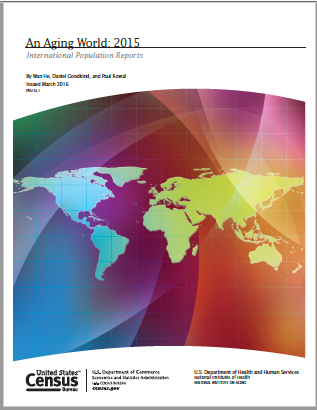Labor Force Participation Rates for An Aging World - 2015
Labor Force Participation Rates for An Aging World - 2015
Today the U.S. Census Bureau released An Aging World-2015, a report that examines the older population’s demographic, health and economic characteristics in the United States and around the world. The Census Bureau regularly tracks trends in international aging and examines their significance. In the coming decades, almost all countries will see an increase in their older population because of expected improvements in health and falling fertility.
Among the key findings highlighted in the report are the proportions of the older population in the labor force (e.g., those who are either employed or seeking employment). The labor force participation rate varies widely across age groups, countries and sex. For instance, at least 90 percent of men in their late 40s are in the labor force in most countries of the world. However, rates generally decline for each successively older age group.
By age 60 to 64, labor force participation rates among men and women were less than half the level for those age 45 to 49 in countries such as South Africa, Tunisia, Italy, Russia and Ukraine (Table 1). Another sizable decline is typically observed for age 65 and over. This is not unexpected, given that individuals may stop working because of increasing frailty, health issues or retirement options. Among women, labor force participation tends to be lower than men across the age groups. The lower proportions of women in the labor force reflect, in part, the fact that women perform unpaid work within a household, which clearly has value and would be expensive to replace but is not included in the formal definition.
There are also notable differences in labor force participation across countries. In general, countries with higher incomes per capita and more developed social security systems tend to have lower labor force participation among the older population. In contrast, in lower income countries, the notion of retirement may not make sense — the older population may need to continue to work, perhaps at a reduced level, until physically or mentally unable to do so.
In Table 1, we see that labor force participation remains above 50 percent for men age 65 and over in Zambia and Guatemala. The World Bank published labor force participation rates for the older population in 25 African countries for 2011 with rates exceeding 50 percent in 12 of the countries.
At the other extreme are Germany and Italy with participation rates below 10 percent for those age 65 and over. The low labor force participation among Europe’s older population likely stems from its substantial economic resources, policies that encourage early retirement and patterns of public spending that provide security for the older population.
Labor force participation rates in the United States, on the other hand, lie well between the extremes of Africa and Europe. Labor force participation rates for U.S. males in 2012 were
88 percent at age 45 to 49, 60 percent at age 60 to 64, and 24 percent at age 65 and above, while U.S. female rates at these age groups were about 10 percentage points lower (76 percent, 50 percent and 14 percent, respectively).
Just as important are changes in labor force participation over time. Between 2001 and 2011, developed countries experienced an increase in labor force participation among the older population. In the United States, for instance, rates at ages 55 to 64 rose from 62 percent to
64 percent, while rates at ages 65 to 69 rose from 26 percent to 32 percent. Other countries with large increases in participation rates over the 2001 to 2011 period include Finland, Germany and the Netherlands.
In the less developed world, the picture was more mixed. There was no clear trend in labor force participation among males, among whom such participation was quite high — typically averaging almost 50 percent at ages 65 and over.
In contrast, labor force participation of older females in developing countries, among which labor force participation is typically under 10 percent, did evince a notable increase from those very low levels.
One of the key megatrends over the past dozen years has been an increase in labor force participation among older women around the world, but the gap between the labor force participation of older men and older women remains. Among the countries shown in Table 2, the gender gap in 2012 ranged from a low of 1.5 percentage points in France to a high of 51.4 percentage points in Guatemala.








